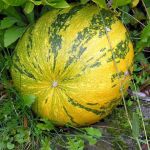| Common Name: |
Winter Squash |
| Other Names: |
Field Pumpkin, Pompion, Pumpkin, Squash |
| Botanical Name: |
Cucurbita maxima, Cucurbita pepo |
| Genus: |
Cucurbita |
| Family: |
Curcurbitaceae |
| Native Location: |
S America |
| Cultivation: |
Rich, well-drained soil in sun. Pinch out tips to encourage growth of lateral shoots. May be affected by mosaic virus, Botrytis, and powdery mildew. Growing on poles or supports protects fruit from slugs. |
| Propagation: |
By seed sown in spring at 16-18°C (61-64°F) |
| Harvest: |
Seeds are collected from ripe fruits in autumn and dried whole (not dehusked for medicinal use) before grinding. |
| Height: |
1m (3ft) |
| :Width |
2m (6ft) |
| Variations: |
Buttercup
Has gray-green fruits, weighing 1.5kg (3.3lb), with firm dense flesh, ideal for roasting, pies, preserves and soups. |
| Hardiness: |
Half Hardy |
| History: |
A member of the Cucurbitaceae family—which includes the cucumbers, gourds, loofahs, melons, squashes, and zucchini—pumpkins have been cultivated in the Americas for over 8,000 years and only traveled to Europe (from Mexico and South America) in the sixteenth century, and to Asia in the seventeenth century. European herbalists considered pumpkin seeds one of the "four greater cold seeds"—along with the seeds of the cucumber, gourd, and melon. All four seeds were pulverized and mixed with water to create a medicinal remedy that soothed inflamed mucous membranes in the nose, throat, chest, intestines, and urinary tract. In Britain, where the pumpkin was known as English Melon, the yellow-orange flesh of the plant was made into soups and pies (a tradition that continues today, on both sides of the Atlantic). In traditional Chinese medicine, pumpkin seeds were (and still are) prized as an aid to longevity. But by far the greatest use of pumpkin seeds was as a remarkably effective and gentle anthelmintic (an herb that expels worms), which is safe for pregnant women and young children. |
| Parts Used: |
Seeds (nan gua zi), fruits, pulp. |
| Properties: |
A sweet, warming, nutty-flavored herb that acts as a diuretic, soothes irritated tissue, and expels intestinal worms. |
| Vitamin Content: |
Vitamin A |
| Medicinal Uses: |
Internally, often combined with Echinacea purpurea (See, echinacea) and Serenoa repens (See, saw palmetto) tapeworms and roundworms; also for motion sickness and early stages of schistosomiasis (seeds). Internally to soothe inflammation of the digestive tract (pulp). Externally as a poultice for burns (Pulp).
Today, many herbalists recommend pumpkin seeds—which are packed with vitamins and minerals—as part of a prostate-healthy diet. The seeds are especially rich in zinc, a mineral critical to optimal prostate function. The cooked flesh (yellow orange pulp) of pumpkin, a kissing cousin of squash, is a fine source of essential minerals, oils, and vitamins. |
| Preparation: |
Whole seeds may be eaten raw or roasted, sprinkled on salads, or baked in breads; they are widely available in supermarkets and health food stores. To maintain a healthy prostate, herbalists recommend eating ½ cup of pumpkin seeds daily. |
| Culinary Uses: |
Dehusked seeds are eaten raw or roasted as a snack, or added to bread. Fruits are steamed, roasted, baked, fried, stuffed, or mashed, and used to make pumpkin filling. Also added to bread, cakes, and muffins. Leaves and flowers are edible, too. |
| Bibliography: |
Encylopedia of Herbs by Deni Brown Copyright ©: 1995, 2001 Dorling Kindersley Limited pg 185
The Modern Herbal Primer by Nancy Burke Copyright©2000 Yankee Publishing, Inc. pp.37-38 |

